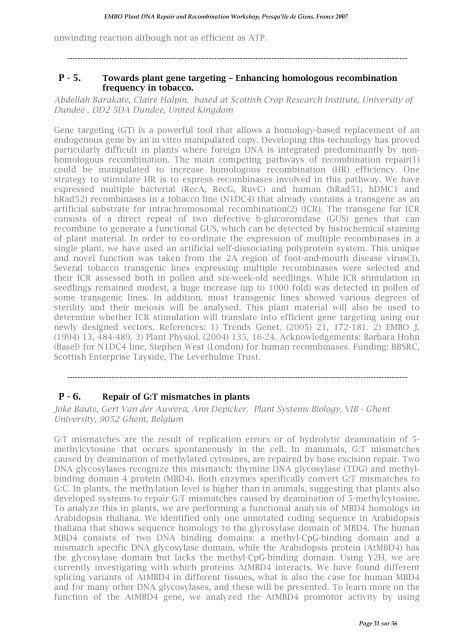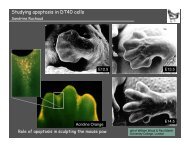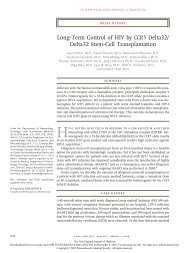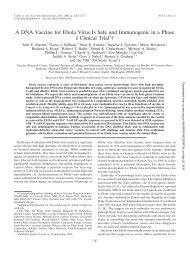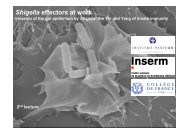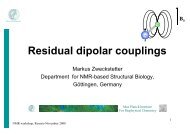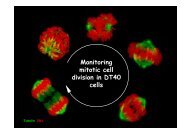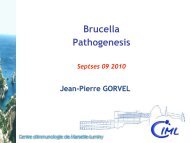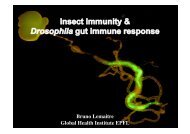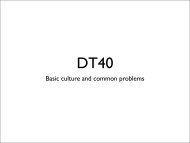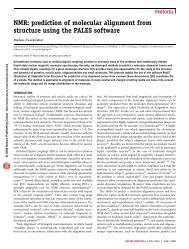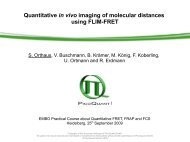pdf file - Events - EMBO
pdf file - Events - EMBO
pdf file - Events - EMBO
Create successful ePaper yourself
Turn your PDF publications into a flip-book with our unique Google optimized e-Paper software.
<strong>EMBO</strong> Plant DNA Repair and Recombination Workshop, Presqu'île de Giens, France 2007<br />
unwinding reaction although not as efficient as ATP.<br />
----------------------------------------------------------------------------------------------------------------------------------<br />
P - 5. Towards plant gene targeting – Enhancing homologous recombination<br />
frequency in tobacco.<br />
Abdellah Barakate, Claire Halpin. based at Scottish Crop Research Institute, University of<br />
Dundee , DD2 5DA Dundee, United Kingdom<br />
Gene targeting (GT) is a powerful tool that allows a homology-based replacement of an<br />
endogenous gene by an in vitro manipulated copy. Developing this technology has proved<br />
particularly difficult in plants where foreign DNA is integrated predominantly by nonhomologous<br />
recombination. The main competing pathways of recombination repair(1)<br />
could be manipulated to increase homologous recombination (HR) efficiency. One<br />
strategy to stimulate HR is to express recombinases involved in this pathway. We have<br />
expressed multiple bacterial (RecA, RecG, RuvC) and human (hRad51, hDMC1 and<br />
hRad52) recombinases in a tobacco line (N1DC4) that already contains a transgene as an<br />
artificial substrate for intrachromosomal recombination(2) (ICR). The transgene for ICR<br />
consists of a direct repeat of two defective b-glucoronidase (GUS) genes that can<br />
recombine to generate a functional GUS, which can be detected by histochemical staining<br />
of plant material. In order to co-ordinate the expression of multiple recombinases in a<br />
single plant, we have used an artificial self-dissociating polyprotein system. This unique<br />
and novel function was taken from the 2A region of foot-and-mouth disease virus(3).<br />
Several tobacco transgenic lines expressing multiple recombinases were selected and<br />
their ICR assessed both in pollen and six-week-old seedlings. While ICR stimulation in<br />
seedlings remained modest, a huge increase (up to 1000 fold) was detected in pollen of<br />
some transgenic lines. In addition, most transgenic lines showed various degrees of<br />
sterility and their meiosis will be analysed. This plant material will also be used to<br />
determine whether ICR stimulation will translate into efficient gene targeting using our<br />
newly designed vectors. References: 1) Trends Genet. (2005) 21, 172-181. 2) <strong>EMBO</strong> J.<br />
(1994) 13, 484-489. 3) Plant Physiol. (2004) 135, 16-24. Acknowledgements: Barbara Hohn<br />
(Basel) for N1DC4 line, Stephen West (London) for human recombinases. Funding: BBSRC,<br />
Scottish Enterprise Tayside, The Leverhulme Trust.<br />
----------------------------------------------------------------------------------------------------------------------------------<br />
P - 6. Repair of G:T mismatches in plants<br />
Joke Baute, Gert Van der Auwera, Ann Depicker. Plant Systems Biology, VIB - Ghent<br />
University, 9052 Ghent, Belgium<br />
G:T mismatches are the result of replication errors or of hydrolytic deamination of 5methylcytosine<br />
that occurs spontaneously in the cell. In mammals, G:T mismatches<br />
caused by deamination of methylated cytosines, are repaired by base excision repair. Two<br />
DNA glycosylases recognize this mismatch: thymine DNA glycosylase (TDG) and methylbinding<br />
domain 4 protein (MBD4). Both enzymes specifically convert G:T mismatches to<br />
G:C. In plants, the methylation level is higher than in animals, suggesting that plants also<br />
developed systems to repair G:T mismatches caused by deamination of 5-methylcytosine.<br />
To analyze this in plants, we are performing a functional analysis of MBD4 homologs in<br />
Arabidopsis thaliana. We identified only one annotated coding sequence in Arabidopsis<br />
thaliana that shows sequence homology to the glycosylase domain of MBD4. The human<br />
MBD4 consists of two DNA binding domains: a methyl-CpG-binding domain and a<br />
mismatch specific DNA glycosylase domain, while the Arabidopsis protein (AtMBD4) has<br />
the glycosylase domain but lacks the methyl-CpG-binding domain. Using Y2H, we are<br />
currently investigating with which proteins AtMBD4 interacts. We have found different<br />
splicing variants of AtMBD4 in different tissues, what is also the case for human MBD4<br />
and for many other DNA glycosylases, and these will be presented. To learn more on the<br />
function of the AtMBD4 gene, we analyzed the AtMBD4 promotor activity by using<br />
Page 31 sur 56


